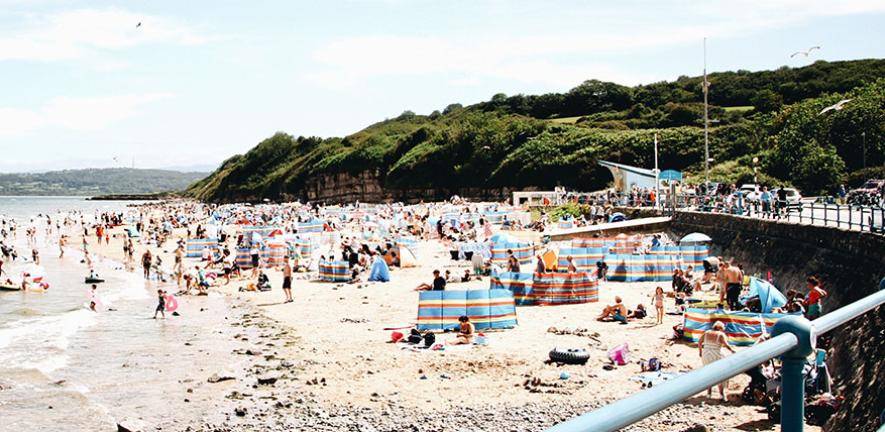
A team led by Professor Flora Samuel from Cambridge’s Department of Architecture has been awarded one of four new £4.625 million Green Transition Ecosystem grants by the Arts and Humanities Research Council (AHRC) to create a Community Open Map Platform (COMP) for Future Generations to chart the green transition on the Isle of Anglesey/Ynys Môn.
A team led by Professor Flora Samuel from Cambridge’s Department of Architecture has been awarded one of four new £4.625 million Green Transition Ecosystem grants by the Arts and Humanities Research Council (AHRC) to create a Community Open Map Platform (COMP) for Future Generations to chart the green transition on the Isle of Anglesey/Ynys Môn.
Climate change cannot be addressed without revealing and tackling the inequalities within society and where they are happening
Flora Samuel
Despite changes to the HM Treasury Green Book to encourage forms of valuation other than economic, local authorities are struggling to capture social, environmental and cultural value in a way that feeds into their systems and processes. This new project aims to make this easy by spatialising data so that it can be used as a basis for targeted hyperlocal action for a green transition.
Professor Flora Samuel said: “Climate change cannot be addressed without revealing and tackling the inequalities within society and where they are happening. Only when we know what is happening where, and how people are adapting to climate change can we make well informed decisions.”
“The aim of this pragmatic project is to create a Community Open Map Platform that will bring together multiple layers of spatial information to give a social, environmental, cultural and economic picture of what is happening in a neighbourhood, area, local authority, region or nation.”
Green Transition Ecosystems (GTEs) are large-scale projects that focus on translating the best design-led research into real-world benefits. Capitalising on clusters of design excellence, GTEs will address distinct challenges posed by the climate crisis including, but not limited to, realising net zero goals.
GTEs are the flagship funding strand of the £25m Future Observatory: Design the Green Transition programme, funded by the AHRC and delivered in partnership with the Design Museum.
The COMP will address the following overarching aims of the Green Transitions Ecosystem call: measurable, green transition-supportive behavioural change across sectors and publics; design that fosters positive behavioural change in support of green transition goals, including strategy and policy; region-focused solutions for example the infrastructure supporting rural communities and, lastly, designing for diversity.
To meet these aims the COMP will deliver a baseline model mapping platform for decision making with communities for use by Local Authorities (LoAs) across the UK and beyond. To do this a pilot COMP will be made for the Isle of Anglesey to help the LoA measure its progress towards a green transition and fulfilment of the Future Generations Wales Act in a transparent and inclusive way.
The Isle of Anglesey/Ynys Môn in North Wales was chosen as the case study for this project largely because it is a discrete geographical place that is rural, disconnected and in decline, with a local authority that has high ambitions to reinvent itself as a centre of sustainable innovation, to be an 'Energy Island’ at the centre of low-carbon energy research and development. The bilingual context of Anglesey provides a particular opportunity to explore issues around multilingual engagement, inclusion and culture – a UK-wide challenge.
The project, a collaboration with the Wales Institute of Social and Economic Research and Data (Wiserd) at Cardiff University and Wrexham Glyndwr University as well as several other partners is supported by the Welsh Government and the Future Generations Commission in Wales who are investigating ways to measure, and spatialise, attainment against the Well-being of Future Generations (Wales) Act (2015), a world-leading piece of sustainability legislation.
The Community Open Map Platform (COMP) will offer a range of well designed and accessible information to communities, local authorities and policy makers alike, as well as opportunities to contribute to the maps. The map layers will constantly grow with information and sophistication, reconfigured according to local policy and boundaries. And crucially, they will be developed and monitored with and by a representative cross section of the local community.
An accessible website will be designed as a data repository tailored to a range of audiences, scalable for use across the UK. Social, cultural and environmental map layers will be co-created with children and young people to show, for instance, where people connect, engage with cultural activities and do small things to adapt to climate change.
The community-made data will be overlaid onto existing census and administrative data sets to build a baseline Future Generations map of the Isle of Anglesey. The layers can be clustered together to measure the island’s progress against the Act but can also be reconfigured to other kinds of measurement schema. In this way the project will offer a model for inclusive, transparent and evidence based planning, offering lessons for the rest of the UK and beyond.
This award is part of the Future Observatory: Design the Green Transition programme, the largest publicly funded design research and innovation programme in the UK. Funded by AHRC in partnership with Future Observatory at the Design Museum, this £25m multimodal investment aims to bring design researchers, universities, and businesses together to catalyse the transition to net zero and a green economy.
Christopher Smith, Executive Chair of the Arts and Humanities Research Council said:
“Design is a critical bridge between research and innovation. Placing the individual act of production or consumption within the context of a wider system of social and economic behaviour is critical to productivity, development and sustainability.
"That’s why design is the essential tool for us to confront and chart a path through our current global and local predicaments, and that’s why AHRC has placed design at the heart of its strategy for collaboration within UKRI.
"From health systems to energy efficiency to sustainability, these four Green Transition Ecosystem projects the UK are at the cutting edge of design, offering models for problem solving, and will touch on lives right across the UK.”

The text in this work is licensed under a Creative Commons Attribution-NonCommercial-ShareAlike 4.0 International License. Images, including our videos, are Copyright ©University of Cambridge and licensors/contributors as identified. All rights reserved. We make our image and video content available in a number of ways – as here, on our main website under its Terms and conditions, and on a range of channels including social media that permit your use and sharing of our content under their respective Terms.




